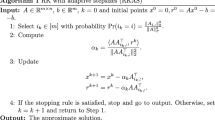Abstract
This paper investigates the randomized version of the Kaczmarz method to solve linear systems in the case where the adjoint of the system matrix is not exact—a situation we refer to as “mismatched adjoint”. We show that the method may still converge both in the over- and underdetermined consistent case under appropriate conditions, and we calculate the expected asymptotic rate of linear convergence. Moreover, we analyze the inconsistent case and obtain results for the method with mismatched adjoint as for the standard method. Finally, we derive a method to compute optimized probabilities for the choice of the rows and illustrate our findings with numerical examples.






Similar content being viewed by others
Notes
If \(\langle a_{i} \,,\, v_{i}\rangle = 0\), Algorithm 1 is not defined and in the case of \(\langle a_{i} \,,\, v_{i}\rangle <0\), the probabilities \(p_{i}\) below in Remark 2.4 would not be non-negative. However, in the case \(\langle a_{i} \,,\, v_{i}\rangle <0\) we could switch the sign of the \(v_{i}\)s, and the expressions in (2.1) and (2.2) would not change).
The code to produce the figures in this article is available at https://github.com/dirloren/rkma.
We could also add a perturbation to A - the numerical results would be rather similar. Setting entries to zero would be numerically beneficial if A would have many small entries, but this was not be the motivation here.
References
Agaskar, A., Wang, C., Lu, Y.M.: Randomized Kaczmarz algorithms: exact MSE analysis and optimal sampling probabilities. In: 2014 IEEE Global Conference on Signal and Information Processing (GlobalSIP), pp. 389–393. IEEE (2014)
De Man, B., Basu, S.: Distance-driven projection and backprojection in three dimensions. Phys. Med. Biol. 49(11), 2463 (2004)
Golub, G.H., Van Loan, C.F.: Matrix Computations, fourth edn. Johns Hopkins Studies in the Mathematical Sciences. Johns Hopkins University Press, Baltimore (2013)
Gordon, R., Bender, R., Herman, G.T.: Algebraic reconstruction techniques (ART) for three-dimensional electron microscopy and X-ray photography. J. Theor. Biol. 29(3), 471–481 (1970)
Hansen, P.C., Saxild-Hansen, M.: AIR tools—a MATLAB package of algebraic iterative reconstruction methods. J. Comput. Appl. Math. 236(8), 2167–2178 (2012)
Kak, A.C., Slaney, M., Wang, G.: Principles of computerized tomographic imaging. Med. Phys. 29(1), 107–107 (2002)
Liu, J., Wright, S.J., Sridhar, S.: An Asynchronous Parallel Randomized Kaczmarz Algorithm. arXiv:1401.4780 (2014)
Needell, D.: Randomized Kaczmarz solver for noisy linear systems. BIT Numer. Math. 50(2), 395–403 (2010). https://doi.org/10.1007/s10543-010-0265-5
Siddon, R.L.: Fast calculation of the exact radiological path for a three-dimensional CT array. Med. Phys. 12(2), 252–255 (1985)
Strohmer, T., Vershynin, R.: A randomized Kaczmarz algorithm with exponential convergence. J. Fourier Anal. Appl. 15(2), 262–278 (2009)
Watson, G.A.: Characterization of the subdifferential of some matrix norms. Linear Algebra Its Appl. 170, 33–45 (1992)
Zeng, G.L., Gullberg, G.T.: Unmatched projector/backprojector pairs in an iterative reconstruction algorithm. IEEE Trans. Med. Imaging 19(5), 548–555 (2000)
Zouzias, A., Freris, N.M.: Randomized extended Kaczmarz for solving least squares. SIAM J. Matrix Anal. Appl. 34(2), 773–793 (2013)
Acknowledgements
The authors thank Emil Sidky and Per Christian Hansen for valuable discussions and the reviewers for helpful remarks.
Author information
Authors and Affiliations
Corresponding author
Additional information
Communicated by Lothar Reichel.
This material was based upon work partially supported by the National Science Foundation under Grant DMS-1127914 to the Statistical and Applied Mathematical Sciences Institute. Any opinions, findings, and conclusions or recommendations expressed in this material are those of the author(s) and do not necessarily reflect the views of the National Science Foundation.
Rights and permissions
About this article
Cite this article
Lorenz, D.A., Rose, S. & Schöpfer, F. The randomized Kaczmarz method with mismatched adjoint. Bit Numer Math 58, 1079–1098 (2018). https://doi.org/10.1007/s10543-018-0717-x
Received:
Accepted:
Published:
Issue Date:
DOI: https://doi.org/10.1007/s10543-018-0717-x




